The first human hand-woven
In addition to providing all his needs from nature, early man also got inspiration from nature in preparing his handiwork. Early humans used caves as houses, animals and plants for food, and animal skins for clothing, flooring, and wall coverings.
A piece of carpet called Pazyryk was found in Russia in 1949 in the middle of snow and ice. This carpet belongs to 350 to 500 years before Christ. This carpet has 3600 knots per square decimeter and its design shows an extremely high skill in this field.
From this valuable sample obtained, it can be concluded that there was a huge support in the design and weaving during the production of this carpet, which is actually a knotted carpet, and this support follows hundreds and thousands of years of activity. Such art shows the existence of simpler weaves in hundreds of years before the production of this carpet, of which the kilim is one of its types. The works found in Behshahr and Tape Sialk in Iran confirm the history of weaving in Iran for thousands of years.
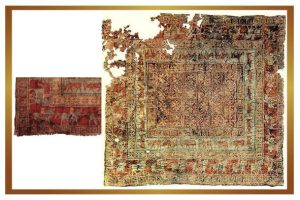
Pazyryk
The first handlooms
The paintings on the caves and the works obtained from thousands of years ago are proof that the early man was in harmony with nature and provided his basic needs, which were food, clothing and security, directly from nature. At first, he used the leaves and stems of trees to cover himself and the living space, then by hunting animals, he prepared clothes and flooring from their skins, he gradually mixed the stems together and prepared mat-like weaves for the floor and covering the walls. . The increase in the hunting of different animals and the raising of domesticated animals caused him to start hand-spinning from the wool and hair of animals. Having the stems and leaves of plants and the hair and wool of animals caused humans to use these materials to prepare clothes, all kinds of utensils and equipment, to cover residences, tents and with the passage of time dozens of other products.

A clay vessel with a base, Shahr-e- Sukhteh – Sistan and Baluchistan – Iran, late second half of the third millennium BC. Notice the movement of the goat in five consecutive positions. This image is the oldest visual expression (animation) from ancient times.
The results of researchers’ efforts in the last hundred years show that Iranians were one of the first tribes to weave cloth. Even the residents of ancient Iran in the Stone Age were familiar with the art of weaving cloth. To prove this fact, the best evidence is the pottery and remains that were found in the historical works of this region more than eight thousand years before Christ. The fabrics found by Professor Carleton Ken in the excavations he obtained in the years 1949 to 1950 in a cave known as the Belt Cave near the Caspian Sea prove that Iranian tribes have been weaving sheep and goat wool into cloth since the beginning of cave-dwelling. Carbon 14 tests on the fabrics showed that they date back to 6500 BC.

Pieces of fabric, Shahr-e- Sukhteh – Sistan and Baluchistan, Iran. Third millennium BC
The anchors and spindles found in various excavations in the last thirty years are proof of the existence of weaving workshops in ancient Iran. Archaeologists such as Prof. Girshman and Dr. Phyllis Ackerman confirm that the age of these spindles and anchors fully corresponds to the first traces of human settlement in the Iranian plateau. In the period of Susa civilization (4500 years BC), the art of fabric weaving has reached perfection due to the elegance of the fabric. The copper blade that was obtained with the pottery of the first era in Susa and the effect of copper salts on the cloth in which the blade was wrapped is proof of this claim. Parts of this cloth are now in the Louvre Museum.
The primary fabrics, Jajim, and kilim were hand-woven fabrics that were created one after the other and with the evolution of the art before it; Although the weaving equipment for cloth, jajim and kilim is not the same, but it has similarities and they were created after the evolution of the previous art. The more important point is that with the completion of the arts, their uses were formed differently from each other, for example, the kilim was never used as a garment, and the fabric was not produced with the underlay philosophy.
Whether it is a hand-woven mat, a kilim or a carpet, it is created as a result of the conflict between the fibers in the length and the fibers in the width. By interweaving the stalks, the early man provided a basic and simple weave that met his first needs and became the beginning of weaving in the world. After that, he used the hair and wool of animals to make thread or thread or something similar. As before, he had used tree fibers to make string. Now a very important element in the weave is ready.
Knitting machines are used to weave products such as jajim and cloth, while looms are used for hand-woven items such as carpets and kilims, which are different in working methods. We will discuss the types of kilim weaving tools in the relevant section.

Knitting machines to weave jajim
In weaving industries, such as kilim weaving, where dyed threads are used, there must be a means to keep the vertical threads during the work so that the threads that are placed in the width of the hand-woven (weft) can pass through them and in addition Create a coherent texture by creating patterns and designs. After the flat weaves, which include mats, cloths, and kilims, old artisans and artists, for more comfort and beauty, passed the threads through the warp and wefts and created a knot, so to speak, felting the handloom. These woolen fibers increase softness and warmth. With the passage of time, the fineness of the threads was added during spinning and more delicate and beautiful handwovens were produced.
So far, we have understood the basics of weaving and how, with the development of the weaving industry, handwoven evolved from the simplest type of weaving, and after simple weavings such as mats, it led to valuable and artistic weavings such as kilims and carpets.
kilim and kilim weaving
What is a kilim? The kilim is hand-woven with a history of several thousand years, which is considered among the first hand-woven by mankind. As it can be seen from the writings of historians and archaeologists, the early man made woven fabrics from the simplest raw materials and used them to protect himself against different climatic conditions.

kilim weaving
Patterns and Designs
As mentioned in the history of the kilim, the artist weaver takes inspiration from nature with his unique creativity and ability to design the kilim and implements them on the kilim by visualizing these patterns in his mind. Often the patterns woven on kilims are subjective and often, the weaver is inspired by nature and what is around him. Animals, plants, objects, people, plains, mountains and valleys can all be a source of inspiration for this artist. Sometimes these motifs are influenced by the culture and mind of the weaver, and the person who weaves the kilim creates a role based on the geographical region, culture, customs and traditions of the tribe and what he sees around him.
Classification of designs on kilims
– Patterns inspired by nature :
these are patterns that are inspired by nature around the weavers; The surrounding animals, plants, nature surrounding the weaver is inspired. These shapes are often woven into the kilim in an abstract form, such as images of animals and plants.
– Motifs related to a tribe:
another category of motifs woven on carpets is related to a particular tribe or tribe. In fact, they consider that people to be the meeting place of that plan. For example, in Sirjan (Kerman-Iran), there is a beautiful painting called Musakhani, which was specific to the Musakhani clan. This design has been adorning the kilims of Sirjan region for many years. For example, we can mention another famous design called Afshari, which is related to Afshar tribe. Since the Afshar tribe is a large tribe and lives in different regions of Iran, the Afshars have various and beautiful designs. Other motifs that fall into this category are motifs that originate from the beliefs, customs and mentality of the people of that tribe.
– Designs related to a region:
The origin of carpet fabric is rural and nomadic areas. It can be said that many regions of Iran have a unique design. For example, Harsin rugs belong to the city of Harsin in Kermanshah province, whose master weavers have presented magnificent examples of rugs and carpets. Another example of this category is Mughan rugs from Mughan city in Ardabil province.
– Copied or replicated designs:
Another category of designs is a copy or copy of a specific design. For example, a weaver uses the design of a machine rug, the image of a magazine, the image on a box, integrated design and the like and tries to implement the same design on a kilim. The design of these kilims is not original. For example, if a picture of a face is woven with a silk texture, the beauty of the texture is original and eye-catching, but the design of the rug will not be original.
– Designed motifs:
In recent decades, kilims have become a commercial product for export, and according to the request of different markets, traders provide special designs and roles to the weaver. This has caused carpet plans to be designed and based on the taste of buyers, the designs are provided to the weavers. The desired motifs, which are sometimes a different and new combination of traditional motifs and sometimes a recreation of old motifs, are painted on checkered papers for carpet design and given to the weaver. From this map, the weaver creates these shapes on woolen or cotton threads.
The remarkable thing about the design and map of the rug is that the elements used in the kilims of different regions of Iran are not completely the same. When we talk about original elements or motifs, there is no place for copied or designed motifs. It means only those patterns and elements that show the authenticity of the kilim. The abstract motifs of animals, evil eyes, flowers and plants and the like in each clan, tribe and nation have their own differences. Usually, the meanings that each nation uses for a motif or pattern used on the kilim are their own. It is derived from the common culture among the same people and it should not necessarily be completely the same as other people.
The thing that needs to be mentioned here is that most of the patterns created on the rugs are inspired by nature, copied from another design, or related to a tribe or tribe. Abstract pattern on the rug
Close. This point multiplies the appeal of hand-woven rugs or local carpets (carpets woven in rural and nomadic areas). One of the characteristics of people’s attraction towards this hand-woven is its abstraction and broken and sometimes geometric patterns.
Colors
color is the beautiful world of differences and charms, and the kilim is one of those hand-woven fabrics, where the variety of colors is often limited, but nevertheless, the colors stand out in a special way in the hand-woven fabric. The use of colors, like designs, is different depending on the type of geographical region, cultures and ethnicities. Another reason for the difference in colors can be customized or borrowed designs from various motifs and images. Colors can also be characteristic of the area of the kilim’s texture, just like the designs in the kilim. In the textures of each region, there are colors that stand out more than other colors. For example, in Baloch kilims, dark red, dark brown, medium brown and dark blue colors, green and red colors are seen a lot. Red, blue, orange, white and green are the dominant colors used in Turkmen kilims. Blue, lacquered red, light brown, white and green colors are very prominent in Kerman kilims.

colors in kilim
dyeing
Fiber dyeing is an art of several thousand years. After early man knew how to weave with wool and cotton fibers, shortly after that he discovered dyeing. Perhaps it is better to say that man was familiar with color before the discovery of weaving by wool and cotton threads. Colored paintings on caves and pottery discovered from the past centuries show that humans knew and used natural colors thousands of years ago.
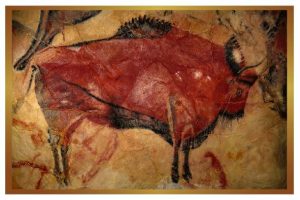
Altamira cave paintings in Spain are among the best preserved cave paintings in the world. This artwork was discovered in the second half of the 19th century by Marcelino Sanz de Sautuola and is said to be between 14,000 and 18,500 years old.
At first, all dyes were taken from nature. These natural materials have been different based on different geographical regions in the world. In Iran, in cities and provinces, the fibers used to produce carpets are dyed with different plants. Most of these plants have been the same and available in different regions of Iran, but the abundance of some plants has been different according to where they grow in certain regions, and dyeing has been done in a similar way in the traditional way. With the growth of the population and increasing needs, the existing natural materials did not meet the needs for mass production, and many natural materials gradually gave way to industrial and chemical materials, and traditional dyeing also became industrial dyeing in many areas.
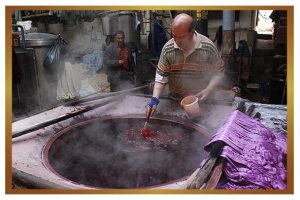
traditional dyeing
Materials used in dyeing
Dyes used for kilim and carpet fibers may be of animal or plant origin. Except for the original dyes, each of which creates a specific color, some materials are also used as stabilizers in dyeing operations. For each color, a special stabilizer is needed. Stabilizers are very important in dyeing and cause the color of the fibers to remain constant. In fact, without stabilizing the color of the fibers, the color of the wool often changes after washing.
Stabilizers, like dyes, may be of plant or animal origin. Vegetable stabilizers are not of good quality and often metal stabilizers are used. Some metal stabilizers used in dyeing wool fibers are: tin, chrome, aluminum, ferrous metals and white alum.
Dyeing of carpet wool fibers with vegetable dyes :
One of the oldest documents about dyeing with plant materials dates back to 450 BC when Herodotus explained the method of using indigo. Runas is also a plant that is thousands of years old, and documents of its use have been discovered in Egypt and Iran. Indigo, green walnut skin, spray, saffron, vesme, pomegranate flower, sumac, gandel and oak tree bark are widely used plant materials in dyeing carpet and kilim fibers.
Dyeing of carpet wool fibers with animal dyes :
The oldest examples related to the use of colors of animal origin are related to a piece of objects and clothes in the excavations of a Greek tomb, which is purple in color and obtained from two types of snails. Another dye that has an animal origin and dates back to ancient times is red seed. The wool fibers used in kilims, carpets and jajims are turned into beautiful colors by red seeds. Red seed is obtained from a type of insect scientifically called coccus, which is very rare. Red seed is one of those dyes that turn kilim fibers into various colors with different stabilizers.
Colors such as purple, magenta, light red, dark red or lacquer, red-brown, purple, violet-purple, green and pink are among those colors.
Raw materials for weaving kilims
The raw materials used for kilim weaving include warp threads and weft threads. In some regions of Iran, they use woolen threads and in some other regions, they use cotton threads for warp. Silk thread is used very little for kilim threads. The warp threads are selected according to the thickness and elegance of the kilim. The color of warp threads is generally white or sugar color. These threads form the vertical part of the kilim and are stronger than the weft threads and have more twist.
The main weft threads or the weaving threads that create the beautiful patterns on the kilim are Alvani threads made of wool, cotton or silk. Woolen and silk threads are often used to weave high-quality and expensive kilims. The thickness of these threads is determined based on the thickness and delicacy of the kilim. In each region of Iran, the texture of a certain type of carpet is famous. The quality, price and design of these kilims and the type of materials they use are not exactly the same. For custom-made kilims, the customer determines the type of yarn and the delicacy of the kilim.
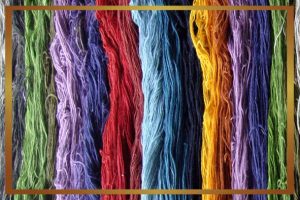
Raw materials for weaving kilims
Necessary tools for kilim weaving
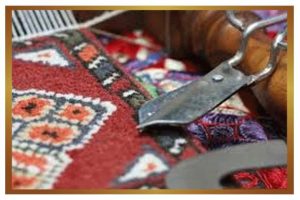
Tools for weaving kilim
kilim weaving, like any other industry, needs work tools. There is no doubt that work tools were simpler in the past because, like other tools, weaving tools have also grown and become more practical, and with the development of technology, more advanced tools have been used. The tools needed for kilim weaving generally include a kilim weaving machine, a comb or daftin, a knife, a hook, scissors, a sewing skewer, and a map. Carpet and rug weaving tools in different regions of the country may not be exactly the same. For example, the comb does not have the same name and the same shape in all weaving areas, but its function is the same.
Handwoven carpet weaving machine
The first weaving tool is the loom. The first looms were very simple devices that created a mat-like texture. All kinds of handwoven fabrics are woven with two types of looms.
The first type consists of hand weaves that are woven by a type of weaving machine that has a harness and generally passing the weft through the threads is done by a shuttle . Handwoven items such as Jajim and all kinds of handwoven fabrics are produced on this type of loom.
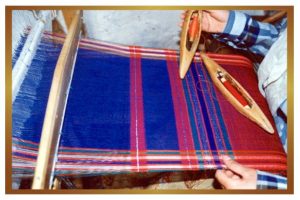
weaving machine
The second type is hand-woven such as rugs, zilo, carpets, etc., which are produced on different looms and differ according to the geographical region and the type of hand-woven.
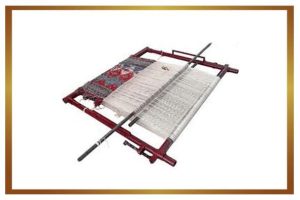
Handwoven kilim weaving machine
There are two types of hand-woven kilim weaving machines; Horizontal loom and vertical loom. Horizontal weaving machines are mostly used in rural and nomadic areas. Although many weavers are used to the horizontal weaving machine to weave kilims or carpets, but the improper position of the weaver on the horizontal or ground weaving machine is scientifically very harmful for his body, but most rural and nomadic weavers who have been on this since childhood The looms have worked, it is not possible for them to change the conditions and in fact to change their habits sometimes. These types of weaving machines are mostly used to weave kilims and rural carpets. Vertical weaving machines are mostly used in urban areas and for carpet weaving. Among some tribes and clans, the use of vertical weaving machines is popular.
The vertical weaving machine is divided into three categories; Fixed vertical loom, rotating vertical loom and Tabriz or Turkish loom.
1- Fixed looms are among the most basic types of vertical looms. In this machine, the weaver must change his sitting place according to the progress of the weaving and move upwards, and when the kilim weaving is finished, the weaver is at the top of the weaving machine.
2- Vertical and rotary knitting machines are machines where the yarn is wrapped around the top and bottom tube. The weaver in front of the machine is weaving the kilim. Whenever the weaver is done with that part, he turns the lower tube with a lever so that the woven part wraps around the lower tube and the part to be woven is placed in front of the weaver.
3-Tabrizi vertical machine or Turkish vertical machine is one of the most convenient and suitable kilim weaving machines. The place where the weaver sits is fixed and the weaver threads are moved. When it is necessary to move the threads, the threads are loosened and the woven part is directed to the back of the machine. In this case, a kilim can be produced as long as the kilim threads.
Rug and carpet weaving comb, daftin or dafe :
during kilim weaving, the wefts pass through the threads and are placed completely on top of each other. The comb is a tool that tightens the conflict between the yarns and wefts of the rug, and the wefts are placed completely on top of each other and there is no gap between them. The comb of carpet and kilim weaving may have different names in different cities. Karkit, Klozar, Dastuk are other names of carpet weaving combs in different regions of Iran.
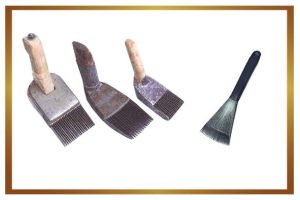
Carpet and kilim weaving comb
The handle of the comb may be wooden or metal, but the teeth must be metal. The dimensions and size of the shoulders and their weight are not the same and are different according to the type of work and the place of weaving. Of course, it seems that large and heavy combs are used for thicker handlooms, and medium combs are used for normal handlooms. The amount of impact that the comb inflicts on the weaves should be proportional to the thickness of the kilim.
Carpet and rug weaving hook :
A hook is a tool that has similar applications in carpet and kilim weaving and is used to catch the warp thread. The wide part in the middle of the hook is used like a knife and is used to cut weft threads and colored threads. In fact, it can be used instead of a knife. Hook is not used for kilim weaving in many areas and is mostly used for carpet weaving.

Carpet and kilim hook
Scissor :
Scissors are used in kilim weaving to remove excess threads on the back or on the kilim. Scissors are also used to trim and straighten raised and knotted areas (in raised kilim). In some kilims, a knotted and raised pattern is woven at the same time as kilim, and finally, the kilim part, which is flat, will have a difference in level with the carpet part. In the last few years, this category of kilims, which are known as kilim-carpet, has received a lot of attention.

scissor

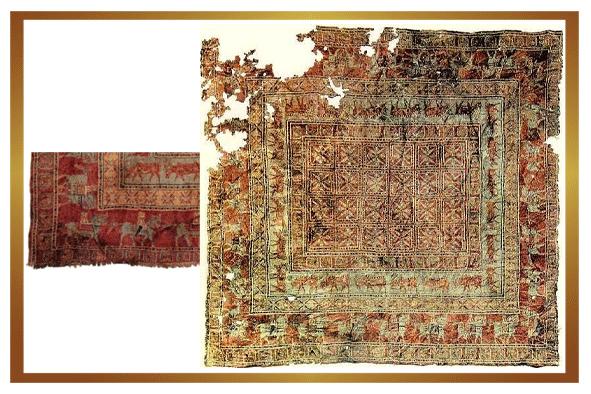

Good
Awesome
Very good
Very good
Good